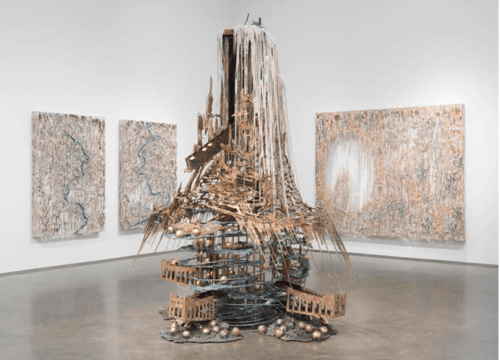
View of Diana Al-Hadid's exhibition "Falcon's Fortress," 2017, showing (foreground) The Candle Clock in the Citadel, 2017, modified polymer gypsum, fiberglass, brass, plaster, metal leaf, and mixed mediums, 117 by 90 by 73 inches, at Marianne Boesky.
In 1206, the inventor Ismael ibn al-Razzaz al-Jazari, a quintessential polymath of the Islamic Golden Age, wrote his Book of Knowledge of Ingenious Mechanical Devices, a compilation of his designs for elaborate, often whimsical apparatuses—among them clocks, fountains, and automata—with detailed descriptions and illustrations of their sophisticated mechanisms. The three sculptures in Syrian American artist Diana Al-Hadid’s recent exhibition “Falcon’s Fortress” (all 2017) took their cues from timekeeping devices detailed in the book: “candle clocks” in which melting candles would trigger complex systems of counterweights and pulleys to release metal balls from the mouths of falcon figures at certain intervals, marking the hours as they passed.
Like much of Al-Hadid’s previous work, these sculptures mimic the aesthetics of ruins, imagining fantastical structures of the past in decaying, degraded form. Positioned at the center of the show, The Candle Clock in the Citadel encases a spiraling form, dotted with gilded balls apparently emerging from the form of a perched brass falcon, in an armature of patinated metal encrusted with faux candlewax, the whole thing resembling an artifact unearthed from a shipwreck. Nearby was The Candle Clock of the Scribe, which suspends a falcon within a network of metal parts that is attached to a base of rough concrete, as if the work had been cut directly out of some distant ground. A smaller side room was given over to The Candle Clock of the Swordsman, in which another outmoded contraption, similarly outfitted with a battered falcon statuette, appears to be hovering magically above the floor atop a base made from pooling drips of wax. The “wax” is, in fact, made from polymer gypsum, but the illusion is at least temporarily convincing, inspiring, I suppose, something akin to the wonderment felt by al-Jazari’s medieval audiences when they encountered his designs.
While these three sculptures were the centerpieces of the exhibition, the most impressive works on display were a series of subtler wall-mounted panels that foreground Al-Hadid’s alchemical work with materials without the baggage of archaeological fantasy. Composed of dripped layers that mix pigmented polymer gypsum, gold leaf, fiberglass, and plaster, the panels are paintings without supports: spindly, shimmering skeins of color that appear to defy the laws of gravity. Even after examining them at length, from every available angle, I couldn’t quite work out how they were made. The effect was amplified by their loosely gridded compositions; through the gaps, varied shadows were cast onto the walls, as if to emphasize the absence of canvas mediating the pictures. Like the exhibition’s sculptures, the panels make reference to a Golden Age source: the miniatures of the Menazilname, a collection of topographic views of the Ottoman Empire that fifteenth-century cartographer Matrakçı Nasuh made while accompanying the imperial army. Though Al-Hadid’s panels appear largely abstract, each contains winding veins of blue pigment that allude to the illustrations of waterways in the originals.
As the exhibition press release notes, the Menazilname includes depictions of Aleppo, Al-Hadid’s birthplace; what it doesn’t mention is that the city has been ravaged by a years-long civil war. But even if the artist never makes that link explicit, the reality of Aleppo’s destruction hung over the works in the show, binding the faux ruins on view to the image of the actual ones.